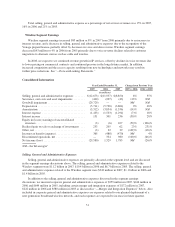Sprint - Nextel 2007 Annual Report Download - page 56
Download and view the complete annual report
Please find page 56 of the 2007 Sprint - Nextel annual report below. You can navigate through the pages in the report by either clicking on the pages listed below, or by using the keyword search tool below to find specific information within the annual report.Discontinued Operations, net
Discontinued operations reflect the results of our Local segment for 2005 and the year-to-date period
through May 17, 2006, the date of the Embarq spin-off. Additional information regarding our discontinued
operations can be found in note 15 of the Notes to Consolidated Financial Statements.
Net Income (Loss)
We recorded a net loss in 2007 as compared to net income in 2006 principally due to a one time non-cash
goodwill impairment charge in our Wireless segment and a decline in the performance of the Wireless segment.
Net income decreased in 2006 compared to 2005 primarily due to the discontinued operations of Embarq in
2006.
We expect downward pressure on our consolidated results of operations in the near term caused principally
by the expected decline in Wireless segment earnings discussed above, together with increased severance, exit
costs. See “—Forward-Looking Statements.”
Critical Accounting Policies and Estimates
We consider the following accounting policies and estimates to be the most important to our financial
position and results of operations, either because of the significance of the financial statement item or because
they require the exercise of significant judgment and/or use of significant estimates. While management believes
that the estimates used are reasonable, actual results could differ from those estimates.
Revenue Recognition and Allowance for Doubtful Accounts Policies
Operating revenues primarily consist of wireless service revenues, revenues generated from handset and
accessory sales and revenues from wholesale operators and PCS Affiliates, as well as long distance voice, data
and Internet revenues. Service revenues consist of fixed monthly recurring charges, variable usage charges such
as roaming, directory assistance, and operator-assisted calling and miscellaneous fees, such as activation,
upgrade, late payment, reconnection and early termination fees and certain regulatory related fees. We recognize
service revenues as services are rendered and equipment revenue when title passes to the dealer or end-user
customer, in accordance with SEC Staff Accounting Bulletin, or SAB, No. 104, Revenue Recognition, and
Emerging Issues Task Force, or EITF, Issue No. 00-21, Revenue Arrangements with Multiple Deliverables. We
recognize revenue for access charges and other services charged at fixed amounts ratably over the service period,
net of credits and adjustments for service discounts, billing disputes and fraud or unauthorized usage. We
recognize excess wireless usage and long distance revenue at contractual rates per minute as minutes are used.
Additionally, we recognize excess wireless data usage based on kilobytes and one-time use charges, such as for
the use of premium services, when rendered. As a result of the cutoff times of our multiple billing cycles each
month, we are required to estimate the amount of subscriber revenues earned but not billed from the end of each
bill cycle to the end of each reporting period. These estimates are based primarily on rate plans in effect and our
historical usage and billing patterns. Subscriber revenue earned but not billed represented about 11.4% of our
accounts receivable balance as of December 31, 2007.
We establish an allowance for doubtful accounts receivable sufficient to cover probable and reasonably
estimable losses. Because of the number of accounts that we have, it is not practical to review the collectibility of
each of those accounts individually when we determine the amount of our allowance for doubtful accounts each
period, although we do perform some account level analysis with respect to large wireless and wireline
customers. Our estimate of the allowance for doubtful accounts considers a number of factors, including
collection experience, aging of the accounts receivable portfolios, the credit quality of our subscriber base,
estimated proceeds from future bad debt sales, and other qualitative considerations, including macro-economic
factors. The accounting estimates related to the recognition of revenue in the results of operations require us to
make assumptions about future billing adjustments for disputes with customers, unauthorized usage, and future
returns and mail-in rebates on handset sales. The allowance amounts recorded represent our best estimate of
54
























